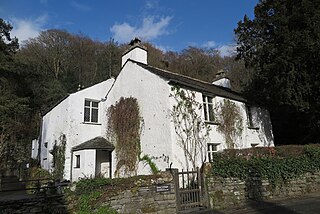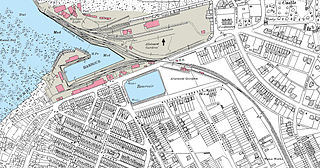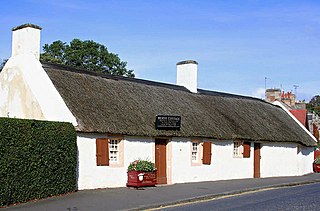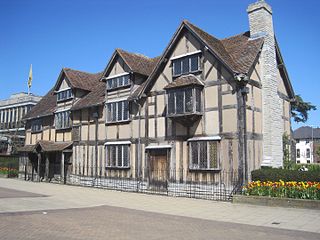
George Stephenson was an English civil engineer and mechanical engineer during the Industrial Revolution. Renowned as the "Father of Railways", Stephenson was considered by the Victorians as a great example of diligent application and thirst for improvement. His chosen rail gauge, sometimes called "Stephenson gauge", was the basis for the 4-foot-8+1⁄2-inch (1.435 m) standard gauge used by most of the world's railways.

Anne Hathaway's Cottage is a twelve-roomed farmhouse where Anne Hathaway, the wife of William Shakespeare, lived as a child in the village of Shottery, Warwickshire, England, about 1 mile (1.6 km) west of Stratford-upon-Avon. Spacious, and with several bedrooms, it is now set in extensive gardens.

Kensington Palace is a royal residence situated within Kensington Gardens in the Royal Borough of Kensington and Chelsea in London, England. It has served as a residence for the British royal family since the 17th century and is currently the official London residence of several royals, including the Prince and Princess of Wales, the Duke and Duchess of Gloucester, the Duke and Duchess of Kent, Prince and Princess Michael of Kent, and Princess Eugenie alongside her husband, Jack Brooksbank, and their two sons. The term "Kensington Palace" is often used as a metonym for the offices of the royals who reside there.

Frogmore is an estate within the Home Park, adjoining Windsor Castle, in Berkshire, England. It comprises 33 acres (130,000 m2), of primarily private gardens managed by the Crown Estate. It is the location of Frogmore House, a royal retreat, and Frogmore Cottage. The name derives from the preponderance of frogs which have always lived in this low-lying and marshy area near the River Thames. This area is part of the local flood plain. Its large landscaped gardens are Grade I listed on the Register of Historic Parks and Gardens.

Abbeydale Industrial Hamlet is an industrial museum in the south of the City of Sheffield, England. The museum forms part of a former steel-working site on the River Sheaf, with a history going back to at least the 13th century. It consists of a number of dwellings and workshops that were formerly the Abbeydale Works—a scythe-making plant that was in operation until the 1930s—and is a remarkably complete example of a 19th-century works. The works are atypical in that much of the production process was completed on the same site. A more typical example of water-powered works in the area can be found at Shepherd Wheel.

Wylam is a village and civil parish in the county of Northumberland, England. It is located about 10 miles (16 km) west of Newcastle upon Tyne.

The Wordsworth Trust is an independent charity in the United Kingdom. It celebrates the life of the poet William Wordsworth, and looks after Dove Cottage in the Lake District village of Grasmere where Wordsworth and his sister Dorothy Wordsworth lived between 1799 and 1808. It also looks after the majority of the surrounding properties in the conservation area of Town End, and a collection of manuscripts, books and fine art relating to Wordsworth and other writers and artists of the Romantic period. In 2020 it introduced the brand name Wordsworth Grasmere.

The Weald and Downland Living Museum is an open-air museum in Singleton, West Sussex. The museum is a registered charity. The museum covers 40 acres (16 ha), with over 50 historic buildings dating from 950AD to the 19th century, along with gardens, farm animals, walks and a mill pond.

The Canterbury and Whitstable Railway, sometimes referred to colloquially as the "Crab and Winkle Line", was an early British railway that opened in 1830 between Canterbury and Whitstable in the county of Kent, England.

New Mill is a Grade II* listed smock mill in Hythe Road, Willesborough, Ashford, Kent. It stands just west of junction 10 of the M20 motorway. It was built in 1869 and is now a museum open to the public.

Arbigland in the historical county of Kirkcudbrightshire, Dumfries and Galloway, Scotland, lies on the coast of the Solway Firth, to the south-east of Kirkbean. It is the birthplace of John Paul Jones, the United States' first well-known naval commander in the American Revolutionary War. There is a birthplace museum in the cottage where he was born, donated by the Blackett family to the John Paul Jones Museum Trust in 1997. The Arbigland Estate also has a number of seaside holiday cottages.
Forest Hall is a village in the borough of North Tyneside, Tyne and Wear, England. It is 4 miles from Newcastle upon Tyne. It borders Killingworth to the north, Holystone to the east and Benton to the south. The village was named after the Forest Hall, which incorporated a medieval tower. Woodside Court was built on the site of the Hall, which was demolished in 1962.

Burns Cottage is the birthplace of Robert Burns, Scotland's national poet, who was born at the cottage on 25 January 1759. It is located in Alloway, a current suburb of Ayr, and a former village, located in South Ayrshire, Scotland. The cottage was built by Robert Burns' father, William Burnes in 1757 and is a four-roomed clay and thatch cottage which has been fully restored to become part of the Robert Burns Birthplace Museum.

Royal Albert Memorial Museum & Art Gallery (RAMM) is a museum and art gallery in Exeter, Devon, the largest in the city. It holds significant and diverse collections in areas such as zoology, anthropology, fine art, local and foreign archaeology and geology.

The Shakespeare Birthplace Trust (SBT) is an independent registered educational charity based in Stratford-upon-Avon, Warwickshire, England, that came into existence in 1847 following the purchase of William Shakespeare's birthplace for preservation as a national memorial. It can also lay claim to be the oldest conservation society in Britain. Receiving no government funding or public subsidies, it is totally dependent upon the public for support, and relies on donations and the income generated from visitors.

Shakespeare's Birthplace is a restored 16th-century half-timbered house situated on Henley Street, Stratford-upon-Avon, Warwickshire, England, where it is believed that William Shakespeare was born in 1564 and spent his childhood years. It is now a small museum open to the public and a popular visitor attraction, owned and managed by the Shakespeare Birthplace Trust.

The Firs in Lower Broadheath, Worcestershire, England was the birthplace of Edward Elgar. The cottage now houses a museum administered by the National Trust. Edward Elgar was born at the house on 2 June 1857, and lived there for the first two years of his life. The museum comprises the Birthplace Cottage and its garden, and the modern Elgar Centre, opened in 2000, which houses further exhibitions and a function room.

Andrew George Stephenson FRSA is a former British politician who most recently served as Minister of State for Health and Secondary Care from November 2023 to July 2024. A member of the Conservative Party, he was the Member of Parliament (MP) for Pendle in Lancashire from 2010 until 2024.

Strawberry Hill House—often called simply Strawberry Hill—is a Gothic Revival villa that was built in Twickenham, London, by Horace Walpole (1717–1797) from 1749 onward. It is a typical example of the "Strawberry Hill Gothic" style of architecture, and it prefigured the nineteenth-century Gothic Revival.

The Ernest Hemingway Birthplace is a historic Queen Anne home and museum in Oak Park, Illinois, United States, where American author Ernest Hemingway was born. Hemingway lived in the home with his family for the first six years of his life. The house was sold out of the Hemingway family in 1905, and it was subsequently renovated and converted into a multi-family residence.




















